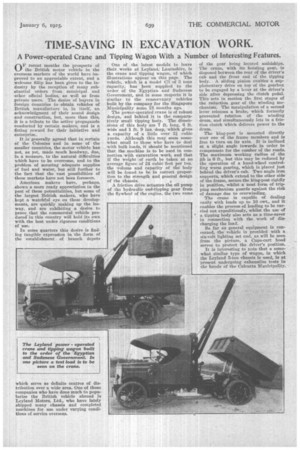TIME-SAVING IN EXCAVATION WORK.
Page 21

If you've noticed an error in this article please click here to report it so we can fix it.
A Power-operated Crane and Tipping Wagon With a Number of Interesting Features.
OFrecent months the prospects of• the British motor vehicle in the overseas markets of the world have improved to an appreciable extent, and a welcome fillip has been given to the industry by the reception of many substantial orders from municipal and other official bodies, as well as from private users. The desire of buyers in foreign countries to obtain vehicles of British manufacture is, in itself, an acknowledgment of their sound design and construction, but, more than this, it is a tribute to the active propaganda conducted by certain makers, and is a• fitting reward for their initiative and enterprise.
It is generally agreed that in certain of the Colonies and in some of the smaller countries, the motor vehicle has not, as yet, made much headway, due, in a measure, to the natural difficulties which have to be overcome, and to the problem of securing adequate supplies of fuel and water, but still further to the fact that the vast possibilities of these markets have not been foreseen.
American makers have, perhaps, shown a more ready appreciation in the past of these potentialities, but some of the largest British makers, who have kept a watchful eye on these developments, are quickly making up the leeway, and are exhibiting a desire to prove. that the commercial vehicle produced in this country will hold its own with the best under rigorous conditions of use.
In some quarters this desire is finding tangible expression in the form of the establishment of branch depots
which serve as definite centres of distribution over a wide area. One of those companies who have done much to popularize the British vehicle abroad is Leyland Motors, Ltd., who have lately shipped many chassis and completed machines for use under varying conditions of service overseas. One of the latest models to leave their, works at Leyland, Lancashire, is the crane and tipping wagon, of which illustrations appear on this page. The vehicle, which is a model C3 of 3 tons capacity, has been supplied to the order of the Egyptian and Sudanese Government, and in some respects it is similar to the conservancy vehicles built by the company for the Singapore Municipality some 18 months ago.
The power-operated crane is of robust design, and behind it is the comparatively small tipping body. The dimensions of this body are 7 ft. long, 6 ft. wide and 1 ft. 9 ins, deep, which gives a capacity of a little over 2i cubic yards. Although this may seem somewhat small to those who have to deal with bulk loads, it should be mentioned that the machine is to be used in connection with excavation work, and that if the weight of earth be taken at an average figure of 24 cubic feet per ton. the volume and capacity of the body will be found to be in correct proportion to the strength and general design of the chaasis.
A friction drive actuates the oil pump of the hydraulic end-tipping gear from the flywheel of the engine, the two rams
of the gear being located amidships. The crane, with its hoisting gear, is disposed between the rear of the driver's cab and the front cud of the tipping body. A sliding pinion enables a supplementary drive on top of the gearbox to be engaged by a lever at the driver's side after depressing the clutch pedal. This sets in motion the first stages of the reduction gear of the winding mechanism. The manipulation of a second lever releases a brake, which formerly prevented rotation of the winding drum, and simultaneously lets in a friction clutch which delivers power to the drum.
The king-post is mounted directly over one of the frame members and is free to tarn on its axis. It is inclined at a slight angle inwards in order to compensate for the camber of the roads. The maximum working radius of the jib is 6 ft., but this may be reduced by the operation of a hand-wheel controlling worm gearing, which is placed just behind the driver's cab. Two angle iron supports, which extend to the other side of the frame, secure the king-post rigidly in position, whilst a neat form of tripping mechanism guards against the risk of damage due to overwinding. The crane is capable of dealing easily with loads up to 10 cwt., and it enables the process of loading to be carried out expeditiously, whilst the use of a tipping body also acts as a time-saver in connection with the work of discharging the load.
So far as general equipment is concerned, the vehicle is provided with a six-volt lighting set and, as will be seen from the picture, a Cape-cart hood serves to protect the driver's position.
It is interesting to note that a somewhat similar type of wagon, in which the Leyland 5-ton chassis is used is at present undergoing exhaustive tests in the hands of the Calcutta Municipality.




























